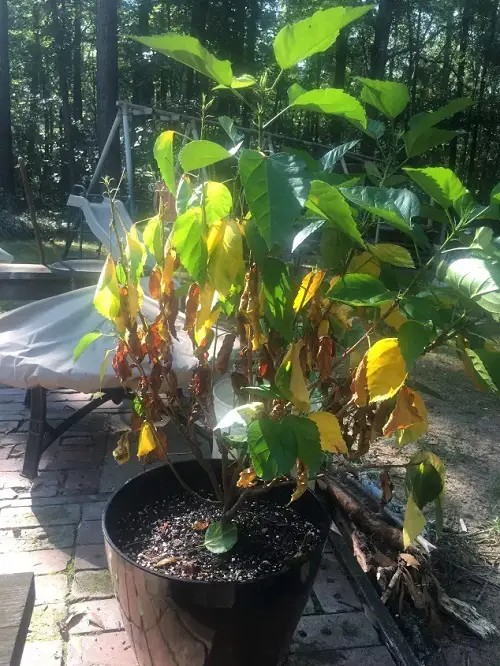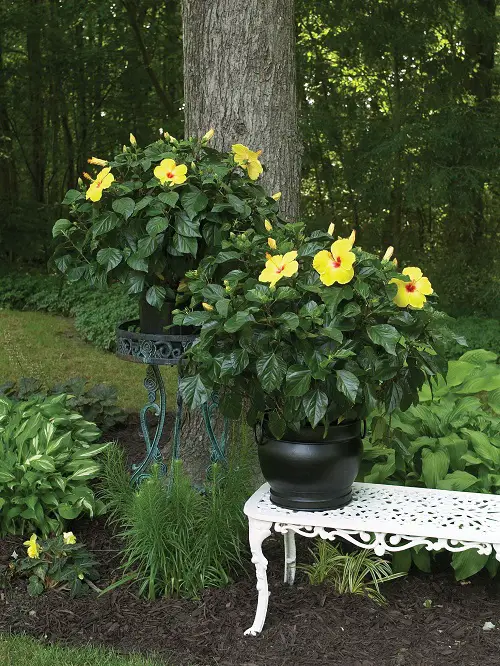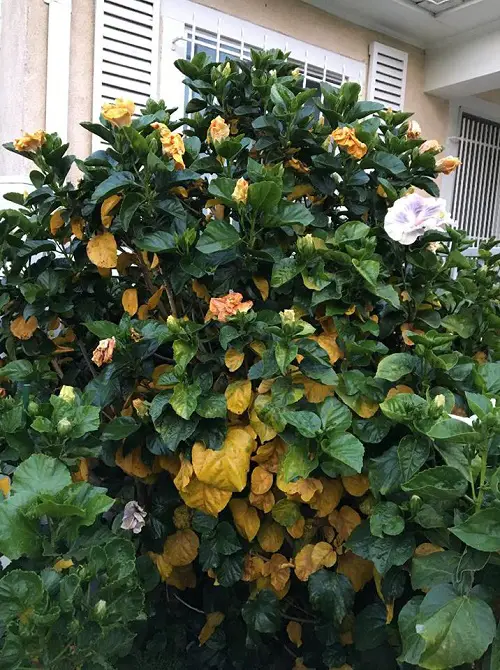Discover the reasons behind Hibiscus Leaves Turning Yellow and practical solutions to restore your plant’s vibrant green foliage.
Are you a hibiscus owner who’s noticed some alarming changes in your plant’s leaves? Fear not; this post is for you! Here are the various reasons behind Hibiscus Leaves Turning Yellow and a guide to help you through some practical solutions!
Hibiscus Plant Information
Hibiscus is a genus of flowering plants in the mallow family, with over 200 species native to warm regions of the world. These plants are known for their large, showy flowers that come in various colors, including red, pink, yellow, and white. Some species have double or even triple blooms, which make them a popular choice for ornamental gardens, as well as for use in traditional medicine and cuisines.
Hibiscus plants also have several health benefits. The flowers and leaves of some species are used to make tea, which is rich in antioxidants and may help reduce high blood pressure and cholesterol levels. Hibiscus extracts are also used in cosmetic products for their anti-inflammatory and skin-soothing properties and hair care.
Hibiscus plants are easy to grow and care for, making them suitable for outdoor gardening and even indoors these days. These plants can be multiplied cheaply and propagated through cuttings.
Check out Fiesta Hibiscus in Garden Ideas With Pictures here
Hibiscus Leaves Turning Yellow | Problems and Solutions
Yellowing leaves in hibiscus plants can be a frustrating problem but don’t worry; it’s usually fixable with some simple solutions. Here are the most common reasons why hibiscus leaves turn yellow and what you can do to fix them:
1. Lack of Nutrients
- Nitrogen Deficiency: This is one of the most common nutrient deficiencies in plants. A lack of nitrogen causes older leaves to turn a pale green or yellow because nitrogen is mobile, and the plant will transport the available nitrogen to the newer leaves.
- Potassium Deficiency: Older leaves may show yellow or brown scorching at the tips and edges, along with black spots on the leaves.
- Iron Deficiency: This results in interveinal chlorosis, where the leaf veins remain green while the areas between them turn yellow. Iron is essential for chlorophyll production. Often, iron might be present in the soil, but a high pH (alkaline soil) can render it unavailable to the plant.
- Magnesium Deficiency: First, the leaf margins turn red, purple, or yellow, followed by interveinal chlorosis in older leaves.
Solution: You can give your plant a balanced fertilizer, either in liquid or granular form, every two to three weeks during the growing season. Be sure to follow the package instructions for the correct dosage and application method. The application of Epsom salt also helps!
Want to Make Organic Fertilizers from Kitchen Scraps? Click here
2. Overwatering

Overwatering can cause the roots of the hibiscus plant to become waterlogged and suffocate, leading to yellowing leaves. This usually happens with potted plants!
- Root Rot: One of the primary issues caused by overwatering is root rot, a condition where the roots begin to decay due to prolonged exposure to excessive moisture. This fungal disease prevents the roots from absorbing nutrients and water, causing the plant to exhibit symptoms like yellowing leaves as it becomes nutrient-starved.
- Impaired Oxygen Uptake: Roots don’t just absorb water; they also require oxygen from the soil. When the soil is continuously wet due to overwatering, the space between soil particles that would typically contain air becomes filled with water, reducing the oxygen available to the roots. This lack of oxygen can lead to root damage and, subsequently, yellowing of the leaves.
Solution: To fix this, use a well-drained substrate and allow the soil to dry out slightly between watering spells, and reduce the frequency of watering. Use a moisture meter to determine when to water your plant, or simply stick your finger in the soil – if it feels dry, it’s time to water.
Here are Signs of Overwatering & How to Save an Overwatered Plant
3. Pests and Diseases
Hibiscus plants can be susceptible to pests and diseases, which can cause the yellowing of leaves. Common pests include spider mites and whiteflies, while fungal infections such as powdery mildew and rust can also cause yellow spots or blotches on the leaves.
Solution: To prevent and treat these issues, keep checking the top and undersides of the foliage regularly and use an effective insecticide or fungicide that is safe for hibiscus plants, following the instructions carefully.
Click here to learn the Amazing Natural Pesticide Recipe that can Kill any Pest
4. Environmental Stress
Changes in environmental conditions can cause stress on hibiscus plants, leading to yellowing leaves. Factors like extreme temperatures, fluctuation, too much direct sunlight, or poor air circulation can all contribute to this.
Solution: To prevent this, provide your plant with the right growing conditions, such as partial sunlight, a stable temperature, and good air circulation. You can also use a shade cloth or move the plant to a more suitable location if necessary if you live in a hot climate.
5. Underwatering
When hibiscus plants are underwatered, their leaves become dry and brittle and may turn yellow and drop.
- Moisture Stress: Hibiscus plants thrive in slightly moist soil conditions. When they don’t receive enough water, they undergo moisture stress. This can lead to the wilting and eventual yellowing of leaves, especially the older ones.
- Impeded Nutrient Uptake: Water is the medium through which plants absorb nutrients from the soil. Inadequate water reduces the plant’s ability to take up essential nutrients. Nutrient deficiencies, such as that of nitrogen, can cause leaves to turn yellow.
- Reduction in Photosynthesis: Water plays a crucial role in the photosynthesis process. A lack of sufficient water can decrease the rate of photosynthesis, leading to reduced energy production. This can cause leaves to turn yellow and drop off as the plant conserves energy.
- Stomatal Closure: Plants have tiny pores on their leaves called stomata, which are responsible for the exchange of gases, including the release of oxygen and the uptake of carbon dioxide. Underwatering causes these stomata to close to prevent further water loss through transpiration. Closed stomata can limit the intake of carbon dioxide, a key component for photosynthesis, further stressing the plant and leading to the yellowing of leaves.
- Cell Damage: Severe underwatering can lead to the breakdown of plant cells. As cells within the leaf tissue become damaged or die due to lack of water, the leaf can turn yellow or brown.
Solution: To prevent this, water your plant regularly, aiming to keep the soil a little moist but not waterlogged or wet. Use a watering can or hose with a spray nozzle to water the plant at the base, avoiding getting water on the leaves. Water whenever the top surface of the soil feels a little dry to the touch.
Look out for these Sure Shot Signs of Underwatered Plants
6. Inadequate Sunlight
Another reason why your hibiscus plant’s leaves might be turning yellow is that it’s not getting enough light.
- Chlorophyll Production: Chlorophyll is the green pigment in plants responsible for photosynthesis. For optimal chlorophyll production, plants require sufficient light. Inadequate sunlight can reduce chlorophyll production, leading to a pale green or yellow coloration of the leaves.
- Energy Production: Photosynthesis is the process through which plants convert sunlight into energy. Without adequate light, the energy production from photosynthesis is reduced. This can lead to a weakening of the plant, causing it to shed older leaves or leaves that are farther from the light source as a means to conserve energy.
- Reduced Nutrient Uptake: A reduction in photosynthesis due to insufficient light can impact the plant’s overall health, leading to decreased nutrient uptake from the soil. A deficiency in essential nutrients can further exacerbate the yellowing of leaves. For instance, a nitrogen deficiency can cause older leaves to turn pale green or yellow.
Solution: Since hibiscus plants prefer warm climates, they love basking in the sun! But be careful not to give them too much direct sunlight, or they might get a little sunburned and develop white spots on their leaves. On the other hand, if they don’t get enough light, they won’t be able to make enough chlorophyll to keep their leaves green and healthy. Aim for full sun to partial shade to help your hibiscus thrive and keep those leaves looking lush and green.






